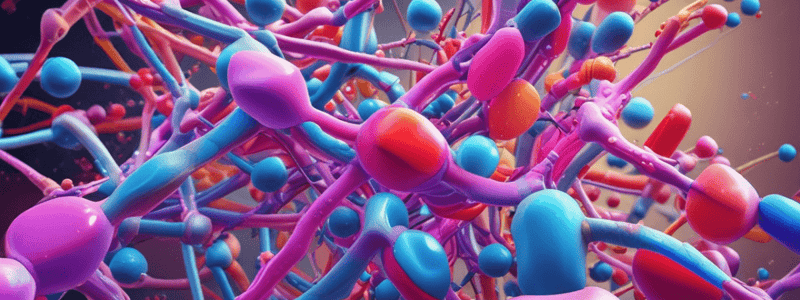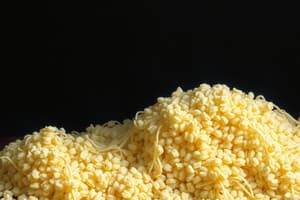Podcast
Questions and Answers
Cellulose is a very strong polysaccharide due to the large number of ______ bonds in and between the fibrils.
Cellulose is a very strong polysaccharide due to the large number of ______ bonds in and between the fibrils.
hydrogen
Glycogen is for ______ storage in animals.
Glycogen is for ______ storage in animals.
glucose
Starch is for ______ storage in plants.
Starch is for ______ storage in plants.
glucose
Cellulose is for ______ strength in plants.
Cellulose is for ______ strength in plants.
Monomers join together by ______ reactions to make polymers.
Monomers join together by ______ reactions to make polymers.
Polymers are ______ back into monomers.
Polymers are ______ back into monomers.
Glycogen is a highly ______ molecule.
Glycogen is a highly ______ molecule.
Glycogen is ______ more branched than starch.
Glycogen is ______ more branched than starch.
Cellulose is the only polysaccharide that is made up of ______ glucose monomers.
Cellulose is the only polysaccharide that is made up of ______ glucose monomers.
The glucose monomers in cellulose are joined by ______ glycosidic bonds.
The glucose monomers in cellulose are joined by ______ glycosidic bonds.
The long, straight chains of β-glucose in cellulose ______ to each other.
The long, straight chains of β-glucose in cellulose ______ to each other.
The function of cellulose is to provide ______ strength in plants.
The function of cellulose is to provide ______ strength in plants.
Glycogen is a polymer made up of α-glucose and is very similar in structure to __________ in starch.
Glycogen is a polymer made up of α-glucose and is very similar in structure to __________ in starch.
The key difference between the structure of glycogen and starch is that glycogen contains more __________ - glycosidic bonds.
The key difference between the structure of glycogen and starch is that glycogen contains more __________ - glycosidic bonds.
Glycogen is insoluble due to the fact it is a __________ molecule.
Glycogen is insoluble due to the fact it is a __________ molecule.
Glycogen is the major carbohydrate storage molecule found in __________ animal cells.
Glycogen is the major carbohydrate storage molecule found in __________ animal cells.
Glycogen is mainly stored in liver and muscle cells to ensure they always have access to __________ to respire and release energy.
Glycogen is mainly stored in liver and muscle cells to ensure they always have access to __________ to respire and release energy.
Glucose is used in respiration, but if more glucose is eaten than the cells need for respiration it is converted into the polymer __________ and stored.
Glucose is used in respiration, but if more glucose is eaten than the cells need for respiration it is converted into the polymer __________ and stored.
What is the main function of cellulose in plants?
What is the main function of cellulose in plants?
How are the glucose monomers in cellulose joined together?
How are the glucose monomers in cellulose joined together?
What property of cellulose makes it a strong structural component in plants?
What property of cellulose makes it a strong structural component in plants?
How do the cellulose fibrils in plant cell walls contribute to the overall strength of the cell wall?
How do the cellulose fibrils in plant cell walls contribute to the overall strength of the cell wall?
What is the main difference between the structure of cellulose and starch?
What is the main difference between the structure of cellulose and starch?
What is the primary function of the hydrogen bonds in cellulose fibrils?
What is the primary function of the hydrogen bonds in cellulose fibrils?
What is the primary structural unit of cellulose?
What is the primary structural unit of cellulose?
Which of the following statements about the structure of cellulose is correct?
Which of the following statements about the structure of cellulose is correct?
What is the primary function of cellulose in plants?
What is the primary function of cellulose in plants?
Which of the following properties of cellulose contributes to its strength?
Which of the following properties of cellulose contributes to its strength?
What is the advantage of cellulose being insoluble in water?
What is the advantage of cellulose being insoluble in water?
How do cellulose fibrils form cellulose fibers?
How do cellulose fibrils form cellulose fibers?
What is the primary function of cellulose in plants?
What is the primary function of cellulose in plants?
Which of the following statements about the structure of cellulose is correct?
Which of the following statements about the structure of cellulose is correct?
What property of cellulose contributes to its ability to provide structural strength in plants?
What property of cellulose contributes to its ability to provide structural strength in plants?
How do the cellulose fibrils in plant cell walls contribute to the prevention of cell bursting?
How do the cellulose fibrils in plant cell walls contribute to the prevention of cell bursting?
Which of the following statements about cellulose is false?
Which of the following statements about cellulose is false?
What is the primary reason for the high mechanical strength of cellulose fibrils?
What is the primary reason for the high mechanical strength of cellulose fibrils?
Flashcards are hidden until you start studying



